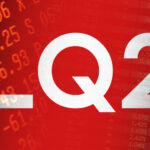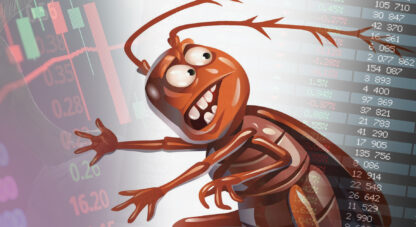“The neutral (or natural) rate of interest is the rate at which real GDP is growing at its trend rate, and inflation is stable. It is attributed to Swedish economist Knut Wicksell, and forms an important part of the Austrian theory of the business cycle. The neutral rate provides an important benchmark for policymakers to compare with the market rate. When interest rates are neutral the economy is on a sustainable path, and it is deviations from neutrality that cause booms and busts.” (Financial Times/lexicon)
“Wicksell based his theory on a comparison of the marginal product of capital with the cost of borrowing money. If the money rate of interest was below the natural rate of return on capital, entrepreneurs would borrow at the money rate to purchase capital (equipment and buildings), thereby increasing demand for all types of resources and their prices; the converse would be true if the money rate was greater than the natural rate of return on capital. So long as the money rate of interest persisted below the natural rate of return on capital, upward price pressures would continue… Price stability would result only when the money rate of interest and the natural rate of return on capital—the marginal product of capital—were equal.” “Wicksell’s Natural Rate”, Federal Reserve Bank of St. Louis Monetary Trends, March 2005
The hypothetical “natural rate” embodies a self-regulating system. During Wicksell’s time, money and Credit entered into the economic system primarily through lending for capital investment. And, importantly, there were constraints on the supply of “money” available to be lent. Banks were the dominant source of lending, and they were subject to specific restraints on Credit expansion (i.e. bank reserve and capital requirements, the gold standard).
Wicksell’s “natural rate” is incompatible with contemporary finance. These days, finance is introduced into systems (economic and financial) with little association to economic returns. Indeed, the primary mechanisms for the creation of new finance are government (fiscal and monetary) spending and asset-based lending. Furthermore, there are no restrains on the available supply of Credit, so its price is outside the purview of supply and demand. For the most part, the government dictates the price of finance. This system is neither self-adjusting nor self-correcting.
Enter the current monetary debate: Things have not progressed as expected. Years of unthinkable monetary stimulus have failed to achieve either general prosperity or consistent inflation in the general price level. Fragilities are as acute as ever. So policymaker reassessment is long overdue. Not surprisingly, however, there’s no second guessing “activist” (inflationist) monetary doctrine. Central bankers are not about to admit that a policy of zero rates and Trillions of monetization is fundamentally flawed. Apparently, we are to believe that forces outside their control have pushed down the “neutral rate.” The solution, predictably, is lower for longer – along with more government spending and programs. So focus on the “neutral rate” becomes the latest elaborate form of policymaking rationalization/justification.
From Ben Bernanke’s August 8, 2016 blog, “The Fed’s Shifting Perspective on the Economy and its Implications for Monetary Policy”: “Projections of r* can be interpreted as estimates of the ‘terminal’ or ‘neutral’ federal funds rate, the level of the funds rate consistent with stable, noninflationary growth in the longer term… As mentioned, a lower value of r* implies that current policy is not as expansionary as thought… In particular, relative to earlier estimates, they see current policy as less accommodative, the labor market as less tight, and inflationary pressures as more limited. Moreover, there may be a greater possibility that running the economy a bit ‘hot’ will lead to better productivity performance over time. The implications of these changes for policy are generally dovish, helping to explain the downward shifts in recent years in the Fed’s anticipated trajectory of rates.”
Today’s monetary “debate” is reminiscent of Alan Greenspan’s fateful foray into New Paradigm worship. In particular, he viewed (going back to 1996) that technological advancement and attendant productivity gains had fundamentally raised the economy’s “speed limit”. Monetary policy could be run looser than in the past – and run it did. Such fallacious thinking was only temporarily discredited with the the bursting of the “tech” Bubble, as captured in a 2001 WSJ article:
December 28, 2001 – Wall Street Journal (Greg Ip and Jacob M. Schlesinger): “Five years ago, Alan Greenspan began pushing a reluctant Federal Reserve to embrace his New Economy vision of rapid productivity growth and rising living standards. Today, Fed policy makers are debating whether they went too far. The answer could help determine whether the current recession marks a temporary aberration in an era of swift growth, or whether the rapid growth of the late 1990s itself was the aberration. Mr. Greenspan hasn’t lost the faith. ‘New capital investment, especially the high-tech type, will continue where it left off,’ he declared in a speech… He ignored the collapse of so many symbols of the 1990s boom, including Enron Corp., the sponsor of the ‘distinguished public service’ award he received that evening. ‘The long-term outlook for productivity growth, as far as I’m concerned, remains substantially undiminished,’ the Fed chairman asserted.”
New technologies are seductive. Rapid technological advancement coupled with momentous financial innovation proved absolutely engrossing. It was easy to ignore Enron, WorldCom and the like, just as it was to disregard 1994’s bond market tumult, the Mexican meltdown, the SE Asia debacle, the Russian collapse and LTCM. By 2001 it was rather obvious that New Age finance was highly unstable. Yet the 2002 corporate debt crisis along with the arrival of Dr. Bernanke to the the Marriner S. Eccles Building ensured that the FOMC pursued even more egregious policy blunders.
The Federal Reserve has been rationalizing loose monetary policies for 20 years now. Instead of Alan Greenspan’s electrifying productivity miracle, it’s a future of dreadful “secular stagnation.” Enron was little small potatoes compared to the frauds that followed. And the key issue from two decades ago somehow remains unaddressed: over-liquefied and speculative securities markets are incapable of effectively allocating financial and real resources. Moreover, central bank command over both the cost of finance and the performance of securities markets ensures dysfunction both financially and economically.
Contemporary notions of a “neutral rate” are deeply flawed – to the point of being ludicrous. From Bloomberg: “The Fed aims to set short-term interest rates in relation to the ‘natural rate’—the one that would produce full employment without excess inflation.” Yet it’s not the Fed funds rate spawning “full employment,” and central bankers certainly do not control a general price level. It is instead the ongoing historic Bubble in market-based finance that dictates the flow of “money” and Credit throughout the economy. One would have to be a diehard optimist to believe either markets or global economies are on a “sustainable path”. Market participants have been incentivized to take excessive risks and to speculate, with central bankers clearly responsible for inflationary Bubbles that have engulfed global securities and asset markets.
There’s no mystery surrounding the sinking employment rate. Ultra-loose monetary policies (rates and QE) have stoked excess securities market inflation, boosting perceived wealth while fostering extremely loose corporate Credit conditions. Such a backdrop spurs business borrowing, spending and hiring. Still, ongoing pathetic growth and productivity dynamics, along with weakening profits, corroborate the view that resources continue to be poorly allocated.
A low unemployment rate concurrent with mild CPI inflation is no conundrum either. On a global basis, unfettered finance has spurred unprecedented over- and malinvestment, ensuring downward price pressures. To be sure, the proliferation of new technologies and digitized output has fundamentally broadened the available supply of goods. Moreover, at home and abroad, unsound global finance has fomented wealth inequality that plays prominently in the disinflationary backdrop more generally.
A low “neutral rate” might be consistent with an economic boom, or it could just as well be compatible with financial and economic collapse. Causation – the driving force behind either boom or bust – is found with intertwined and closely correlated global securities markets. Two decades of persistently loose monetary policies have created deep economic maladjustment and historic asset price Bubbles. And these days central bankers see resulting stagnation (growth, productivity, pricing power, profits, etc.) as evidence of a historically low “neutral rate” – that is then used to justify their runaway experiment in ultra-loose monetary management.
Back in 2013, in the midst of a bout of market tumult, chairman Bernanke reassured the markets that the Fed was prepared to “push back against a tightening of financial conditions.” In the eyes of the market, this significantly augmented/clarified “whatever it takes.” The Federal Reserve – and global central bankers more generally – could simply not tolerate fledgling risk aversion (“risk off”) in the securities markets that would impinge financial conditions more generally. The Fed would use its rate and QE policy specifically to backstop the securities markets, in the process sustaining Bubble Dynamics.
“Whatever it takes” and “pushing back” unleashed a precarious Terminal Bubble Phase. With economic and market risks now so elevated, even the thought of recession or bear market has become unacceptable to central bankers.
There was a research piece this week from Federal Reserve Bank of San Francisco President John Williams, “Monetary Policy in a Low R-star World:” “The time has come to critically reassess prevailing policy frameworks and consider adjustments to handle new challenges, specifically those related to a low natural real rate of interest. While price level or nominal GDP targeting by monetary authorities are options, fiscal and other policies must also take on some of the burden to help sustain economic growth and stability.” And there was Thursday’s Washington Post op-ed from Larry Summers: “What We Need to do to Get Out of This Economic Malaise.” “I cannot see how policy could go wrong by setting a level target of 4 to 5% growth in nominal gross domestic product and think that there could be substantial benefits.”
Let me suggest what is going wrong. Even after several years of typical recovery, there would be the issue of mounting imbalances and excesses. With almost eight years of history’s most extreme monetary stimulus – including zero rates, massive monetization and the direct targeting of securities and asset inflation – there is surely an extraordinary degree of underlying economic maladjustment. One should expect an inordinate number of uneconomic enterprises, along with the now typical amounts of fraud and nonsense (that prosper on loose finance).
Historic excess and distortions have for years accumulated throughout the securities markets. The underlying amount of speculative leverage likely exceeds 2008. Eight years of Federal Reserve zero rates and liquidity backstops have severely perverted market risk perceptions. Literally Trillions have flowed into perceived liquid and low-risk securities – fixed-income and equities. Trillions have chased yields and returns, assuming liquidity while being indifferent to risk. The unwieldy global pool of speculative finance has inflated by Trillions. Meanwhile, the Fed’s serial interventions to smother “Risk Off” has undoubtedly cultivated major latent fragilities within the derivatives trading complex.
The current policy objective should be for Fed to begin extricating itself from market dominance. It’s absolutely crucial for the economy and markets to commence the process of learning to stand on their own. At this point, such a transition would not go smoothly. The alternative is only deeper structural impairment and more extreme financial and economic fragility.
The system has been put in a quite precarious position, but it’s time to let Capitalism sorts its way through. The very opposite seems ensured. We’re in the early stage of even more egregious government (fiscal and monetary) intervention in the economy and markets. The election will usher in a surge of deficit spending. Meanwhile, the Federal Reserve appears poised to use a low “neutral rate” as an excuse to cling to ultra-loose monetary policies.
I am often reminded of misguided late-nineties dollar optimism. New Paradigm thinking had the markets content to overlook underlying U.S. financial and economic fragilities, not to mention massive intractable Current Account Deficits. King dollar had become a Crowded Trade, although nothing in comparison to this cycle’s dollar exuberance. Curiously, the dollar index declined 1.2% this week. In the face of Japan’s deep problems and policy shortcomings, the $/yen traded below 100 this week (yen up 16.9% y-t-d). Despite the eurozone’s serious deficiencies, the euro ended the week above 113 (up 4.3% y-t-d). In general, emerging markets are a mess, yet many EM currencies have rallied strongly against the dollar.
Integral to the dollar bull case have been expectations that an outperforming U.S. economy would ensure rising U.S. rates and attractive interest-rate differentials. Yet king dollar excesses (foreign and speculative flows) exacerbated Bubble Dynamics, with market and economic vulnerabilities now having trapped the Yellen Fed in ultra-loose monetary measures. Global markets appear to have begun anticipating a weaker dollar. This would certainly help to explain the big turnarounds in commodities and EM.
If the Fed is hellbent on spurring inflation (at home and abroad), a weaker dollar could go a long way. But policy savants be careful what you wish for. After all, global markets are awash in Crowded Trades betting on dollar strength, disinflationary forces, low bond yields and market stability – as far as the eye can see. There is today no “neutral rate” that could possibly neutralize such a perilous global Bubble.
For the Week:
The S&P500 was unchanged (up 6.8% y-t-d), while the Dow slipped 0.1% (up 6.5%). The Utilities dropped 1.3% (up 16.2%). The Banks jumped 1.7% (down 3.9%), and the Broker/Dealers rose 1.1% (down 6.3%). The Transports advanced 1.6% (up 5.6%). The S&P 400 Midcaps added 0.3% (up 11.7%), and the small cap Russell 2000 increased 0.6% (up 8.9%). The Nasdaq100 was unchanged (up 4.6%), and the Morgan Stanley High Tech index gained 1.2% (up 9.1%). The Semiconductors jumped 2.2% (up 20.1%). The Biotechs declined 0.7% (down 13.0%). Though bullion added $6, the HUI gold index fell 3.6% (up 142%).
Three-month Treasury bill rates ended the week at 30 bps. Two-year government yields rose five bps to 0.75% (down 30bps y-t-d). Five-year T-note yields rose seven bps to 1.16% (down 59bps). Ten-year Treasury yields gained seven bps to 1.58% (down 67bps). Long bond yields increased six bps to 2.29% (down 73bps).
Greek 10-year yields fell 13 bps to 7.86% (up 54bps y-t-d). Ten-year Portuguese yields surged 31 bps to 2.98% (up 46bps). Italian 10-year yields jumped nine bps to 1.13% (down 46bps). Spain’s 10-year yield increased three bps to 0.95% (down 82bps). German bund yields rose seven bps to negative 0.04% (down 66bps). French yields gained seven bps to 0.18% (down 81bps). The French to German 10-year bond spread was unchanged at 22 bps. U.K. 10-year gilt yields rose 10 bps to 0.62% (down 134bps). U.K.’s FTSE equities index declined 0.8% (up 9.9%).
Japan’s Nikkei 225 equities index dropped 2.2% (down 13.1% y-t-d). Japanese 10-year “JGB” yields increased three bps to negative 0.09% (down 26bps y-t-d). The German DAX equities index fell 1.6% (down 1.8%). Spain’s IBEX 35 equities index sank 3.0% (down 11.5%). Italy’s FTSE MIB index was hit 4.0% (down 23.9%). EM equities were mixed. Brazil’s Bovespa index gained another 1.5% (up 36.5%). Mexico’s Bolsa was little changed (up 12.4%). South Korea’s Kospi index added 0.3% (up 4.8%). India’s Sensex equities slipped 0.3% (up 7.5%). China’s Shanghai Exchange jumped 1.9% (down 12.2%). Turkey’s Borsa Istanbul National 100 index was about unchanged (up 8.9%). Russia’s MICEX equities index slipped 0.4% (up 11.3%).
Junk bond mutual funds saw inflows of $889 million (from Lipper).
Freddie Mac 30-year fixed mortgage rates declined two bps to 3.43% (down 54bps y-o-y). Fifteen-year rates slipped two bps to 2.74% (down 52bps). Bankrate’s survey of jumbo mortgage borrowing costs had 30-yr fixed rates up three bps to 3.61% (down 47bps).
Federal Reserve Credit last week expanded $10.4bn to $4.438 TN. Over the past year, Fed Credit declined $22.3bn. Fed Credit inflated $1.627 TN, or 58%, over the past 197 weeks. Elsewhere, Fed holdings for foreign owners of Treasury, Agency Debt increased $2.9bn last week to $3.203 TN. “Custody holdings” were down $153bn y-o-y, or 4.6%.
M2 (narrow) “money” supply last week increased $5.6bn to a record $12.971 TN. “Narrow money” expanded $884bn, or 7.3%, over the past year. For the week, Currency increased $0.8bn. Total Checkable Deposits surged $69.8bn, while Savings Deposits dropped $65.3bn. Small Time Deposits added $1.0bn. Retail Money Funds slipped $0.7bn.
Total money market fund assets dropped $34.9bn to a six-week low $2.710 TN. Money Funds rose $24bn y-o-y (0.9%).
Total Commercial Paper dropped $11.0bn to $1.012 TN. CP declined $45bn y-o-y, or 4.2%.
Currency Watch:
The U.S. dollar index dropped 1.2% to 94.5 (down 4.2% y-t-d). For the week on the upside, the euro increased 1.5%, the Swiss franc 1.4%, the British pound 1.2%, the Japanese yen 1.1%, the New Zealand dollar 1.0%, the Swedish krona 0.8%, the Canadian dollar 0.6%, and the Mexican peso 0.2%. For the week on the downside, the Brazilian real declined 0.4%, the Australian dollar 0.3%, the South African rand 0.3%, and the Norwegian krone 0.1%. The Chinese yuan declined 0.3% versus the dollar (down 2.5% y-t-d).
Commodities Watch:
The Goldman Sachs Commodities Index surged 4.9% (up 18.9% y-t-d). Spot Gold added 0.4% to $1,341 (up 26%). Silver declined 2.1% to $19.31 (up 40%). WTI Crude surged $4.08 to $48.57 (up 31%). Gasoline jumped 10.8% (up 20%), while Natural Gas slipped 0.4% (up 10%). Copper gained 1.8% (up 2%). Wheat surged 5.3% (down 5%). Corn advanced 3.2% (down 4%).
Turkey Watch:
August 14 – Reuters (Humeyra Pamuk): “Turkey will not compromise with Washington over the extradition of the Islamic cleric it accuses of orchestrating a failed coup, Prime Minister Binali Yildirim said…, warning of rising anti-Americanism if the United States fails to extradite.”
August 18 – Reuters (Ayla Jean Yackley): “Turkish authorities ordered the detention of nearly 200 people, including leading businessmen, and seized their assets as an investigation into suspects in last month’s failed military rebellion shifted to the private sector. President Tayyip Erdogan has vowed to choke off businesses linked to U.S.-based Muslim cleric Fethullah Gulen, whom he blames for the July 15 coup attempt, describing his schools, firms and charities as ‘nests of terrorism.’ Tens of thousands of troops, civil servants, judges and officials have been detained or dismissed in a massive purge…”
August 14 – Reuters (Michelle Martin and Humeyra Pamuk): “Turkey could walk away from its promise to stem the flow of illegal migrants to Europe if the European Union fails to grant Turks visa-free travel to the bloc in October, Foreign Minister Mevlut Cavusoglu told a German newspaper. His comments… coincide with rising tensions between Ankara and the West that have been exacerbated by the failed coup attempt… Turkey is incensed by what it sees as an insensitive response from Western allies to the failed putsch, in which 240 people were killed.”
Brexit Watch:
August 13 – Bloomberg (Scott Hamilton and Colin Keatinge): “Monetary policy is only a ‘short-term balm’ that can’t fully insulate the U.K. from the long-term impacts of the vote to leave the European Union, Bank of England Chief Economist Andrew Haldane wrote… The bank’s package of monetary policy measures unleashed earlier this month, including the first interest-rate cut in seven years, are designed to be a shot in the arm for business and consumer confidence after the vote to leave the European Union ‘has thrown up a dust cloud of economic uncertainty, making it harder for companies to plan, with potentially adverse implications for future investment and jobs,’ Haldane said…”
August 15 – Reuters (Ana Nicolaci da Costa): “The price of homes for sale in England and Wales fell in August, posting the biggest drop since November… Asking prices fell by a monthly 1.2%…, after shedding 0.9% in July. The biggest drop was in London and the South East, with asking prices falling by 2.6% and 2.0% respectively.”
August 16 – Bloomberg (Janet Lorin): “Larger investment banks with their European headquarters in London are already making plans for their own withdrawal. Many plan to start the process of moving jobs from the U.K. within weeks of the government triggering Brexit, people briefed on the plans of four of the biggest firms told Bloomberg’s Gavin Finch. That suggests the banks may move faster than their public messages of patience would imply, and reflects dismay with the U.K.’s lack of a clear plan to protect its status as a global financial hub. There are concerns British-based banks will lose the right to sell services freely around the European Union.”
Europe Watch:
August 18 – New York Times (Landon Thomas Jr.): “In Italy, where two decades of economic stagnation have created a long line of barely breathing companies, Feltrinelli, one of the country’s largest booksellers, stands out. Since 2012, the company has chalked up three consecutive years of losses totaling nearly 11 million euros ($12.4 million). Even so, late last year, Feltrinelli was able to secure a fresh €50 million line of credit from a syndicate that included two of Italy’s largest banks, UniCredit and Intesa Sanpaolo, at an interest rate below what top-rated companies in Europe were paying. As Italy and Europe more broadly struggle to come to grips with an escalating problem with bad loans, a new paper by economists connected to the Center for Economic Policy Research… highlights the extent to which Italy’s main banks — known to be the weakest in the eurozone in terms of cash reserves — have stepped up their lending to the country’s most troubled companies.”
Fixed-Income Bubble Watch:
August 14 – Wall Street Journal (Carolyn Cui and Mike Bird): “Bond investment funds that usually have little appetite for riskier debt are boosting their exposure to the developing world, a move that is helping drive this year’s emerging-markets rally. International bond funds run by BlackRock Inc., Legg Mason Inc. and OppenheimerFunds are among the big money managers that have been increasing their positions in emerging-market debt in recent months. That shift reflects how global bond funds are feeling the pinch from low U.S. interest rates and negative rates in Japan and much of Europe.”
Global Bubble Watch:
August 18 – New York Times (Robin Wigglesworth): “Paul Singer, head of $28bn hedge fund Elliott Management, has warned that the global bond market is ‘broken’, and predicted that the end of the current environment is ‘likely to be surprising, sudden, intense, and large’… In his second quarter letter to investors… Mr Singer sounded an ominous warning on the state of the global debt market, with more than $13tn of bonds trading with negative yields. The hedge fund manager said it was ‘the biggest bond bubble in world history,’ and cautioned that investors should shy away from sub-zero yielding debt. ‘Hold such instruments at your own risk; danger of serious injury or death to your capital!’, he wrote… He added that ‘the ultimate breakdown (or series of breakdowns) from this environment is likely to be surprising, sudden, intense, and large’.”
August 16 – Reuters (Claire Milhench): “Global investors have cut their cash holdings sharply and added to emerging market and U.S. stocks in August as global growth expectations have rebounded, a Bank of America Merrill Lynch (BAML) survey indicated… Cash levels dropped to 5.4% from a 15-year high of 5.8% in July… A net 23% of investors now expect the global economy to improve over the next 12 months, an optimism reflected in the overall equity allocation recovering to a net overweight of 9%. This was up from a net 1% underweight last month – the first underweight in four years. Among the biggest beneficiaries of this switch were emerging market stocks, where the allocation rose to a net 13% overweight – the highest level since September 2014. This was up from 10% last month.”
August 16 – Bloomberg (Vincent Cignarella): “This wasn’t supposed to happen. The central banks of Australia and New Zealand lowered benchmark interest rates and their respective currencies promptly strengthened. Traders puzzled by the way foreign-exchange markets are behaving should consider that potential for capital appreciation, in addition to yield, may be a significant driver of recent moves. Investors are engaging in a type of ‘reverse carry trade,’ buying low-yield currencies for high-yield pairs and accepting small interest rate differential losses for potential large capital gains where central banks are cutting rates or buying more domestic bonds. Those moves should push up the price of underlying assets and, in theory, outweigh small losses on interest rate carry.”
U.S. Bubble Watch:
August 18 – The Economist: “WHAT are the most dysfunctional parts of the global financial system? China’s banking industry, you might say, with its great wall of bad debts and state-sponsored cronyism. Or the euro zone’s taped-together single currency, which stretches across 19 different countries, each with its own debts and frail financial firms. Both are worrying. But if sheer size is your yardstick, nothing beats America’s housing market. It is the world’s largest asset class, worth $26 trillion, more than America’s stockmarket. The slab of mortgage debt lurking beneath it is the planet’s biggest concentration of financial risk. When house prices started tumbling in the summer of 2006, a chain reaction led to a global crisis in 2008-09. A decade on, the presumption is that the mortgage-debt monster has been tamed. In fact, vast, nationalised, unprofitable and undercapitalised, it remains a menace to the world’s biggest economy.”
August 18 – Bloomberg (Joe Light): “The hole at the corner of 15th and L streets, in downtown Washington, is deep — and getting deeper. Earth-movers there are laying the foundations of a shiny new headquarters for Fannie Mae, the bailed-out giant of American mortgages. But the sleek design, replete with glass sky bridges, belies a sober reality: Fannie Mae and its cousin, Freddie Mac, are once again headed for trouble. In fact, there’s almost no way around it. On Jan. 1, 2018, the two government-sponsored enterprises will officially run out of capital under the current terms of their bailout. After that, any losses would be shouldered by taxpayers. Granted, few people are predicting a disaster like the one in 2008, when the GSEs had to be thrown a $187.5 billion federal lifeline. But eight years later, people still don’t agree on what to do with these wards of the state… ‘Everyone agreed that this was a broken business model that made no sense,’’ said Douglas Holtz-Eakin, president of the American Action Forum… ‘Now, inertia is driving the way.’”
August 16 – Bloomberg (Sid Verma and Luke Kawa): “Stock buybacks appear to be slowing down, suggesting either corporate America’s outlook has dimmed, stock valuations have become prohibitively high or, most optimistically, that companies are starting to listen to investors and put funds toward other uses. Buybacks announced for the second quarter’s earnings season between July 8 and August 15 totaled an average of $1.8 billion a day, the lowest volume in an earnings season since the summer of 2012, according to TrimTabs Investment Research… In the first seven months of 2016, buybacks totaled $376.5 billion, according to TrimTabs. That’s down 21% from $478.4 billion in the first seven months of last year.”
August 19 – Wall Street Journal (Mike Bird, Vipal Monga and Aaron Kuriloff): “Big companies are handing more of their profits to shareholders than at any time since the financial crisis, as record-low bond yields put a premium on dividends. Payouts at S&P 500 companies for the past 12 months amounted to almost 38% of net income over the period, according to FactSet, the most since February 2009. In the second quarter, 44 S&P 500 companies paid an annual dividend that exceeded their latest 12 months of net income… That is the most in a decade and a practice some analysts deem unsustainable.”
August 12 – Wall Street Journal (Maria Armental): “As U.S. stocks rally, private-equity firms are taking the other side of the trade. The S&P 500, Dow Jones Industrial Average and Nasdaq Composite Index all notched record highs Thursday, a triple-threat that hadn’t occurred since the dot-com boom. Meanwhile, 15 block trades, bulk sales of big chunks of stock, raised a total of $5 billion in the biggest week for such deals since March 2015. Private-equity firms, which use block trades to sell out of companies they previously took public, accounted for nine of the 15 deals.”
August 17 – Bloomberg (Rachel Evans): “Store closures by Macy’s Inc. could hurt more than the mall rats, according to Morningstar Credit Ratings. Almost $30 billion of bonds backed by commercial mortgages are exposed to the retailer, which last week announced plans to shutter 100 outlets, the rating company wrote… More than $3.6 billion in loans would be affected by the closing of 28 stores that Morningstar identifies as most at risk, several of which support multiple asset-backed securities…”
Federal Reserve Watch:
August 17 – Financial Times (Sam Fleming): “A divided Federal Reserve left open the prospect of a further interest rate rise this year even as policymakers insisted they needed more evidence on the durability of the rebound before feeling confident enough to pull the trigger. Minutes to their latest July meeting revealed a hard-fought debate over when to move rates, with a couple of participants urging an immediate move, while others were urging caution amid questions over how rapidly inflation will return to target.”
August 16 – Bloomberg (Matthew Boesler): “The Federal Reserve could potentially raise interest rates as soon as next month, New York Fed President William Dudley said, warning investors that they are underestimating the likelihood of increases in borrowing costs. ‘We’re edging closer towards the point in time where it will be appropriate, I think, to raise interest rates further,’ Dudley… said… Asked whether the FOMC could vote to raise the benchmark rate at its next meeting Sept. 20-21, Dudley said, ‘I think it’s possible.’”
Central Bank Watch:
August 16 – Bloomberg (Jeanna Smialek): “The world made it through the Great Recession. Now it’s entered what you might call the Great Reassessment. High-profile researchers are publicly questioning the most basic tenets of monetary policy in the run-up to the Federal Reserve Bank of Kansas City’s economic symposium in Jackson Hole, Wyoming, which starts Aug. 25. San Francisco Fed President John Williams has issued a call for a major rethink among central bankers and fiscal policy makers, with an eye on scrapping low-inflation targeting. Former Fed Chairman Ben Bernanke analyzes why the Fed has been revising its economic projections. Meanwhile, a new IMF paper assesses both the effectiveness of, and the outlook for, Europe’s negative interest-rate policies.”
August 18 – Bloomberg (Jana Randow and Carolynn Look): “European Central Bank officials ‘widely’ agreed that their immediate reaction to the outcome of the U.K.’s referendum shouldn’t fuel excessive speculation about more stimulus. ‘The view was widely shared that the Governing Council needed to reiterate its capacity and readiness to act, if warranted, to achieve its objective, using all the instruments available within its mandate, while not fostering undue expectations about the future course of monetary policy,’…”
China Bubble Watch:
August 12 – Bloomberg (Paul Panckhurst): “International Monetary Fund staff said that 19 trillion yuan ($2.9 trillion) of Chinese ‘shadow’ credit products are high-risk compared with corporate loans and highlighted the danger that defaults could lead to liquidity shocks. The investment products are structured by the likes of trust and securities companies and based on equities or on debt — typically loans — that isn’t traded… The commentary highlighted the potential for risks bigger to the nation’s financial stability than from companies’ loan defaults. While loan losses can be realized gradually, defaults on the shadow products could trigger risk aversion that’s harder to manage… The ‘high-risk’ products offer yields of 11% to 14%, compared with 6 percent on loans and 3% to 4% on bonds, the commentary said. The lowest-quality of these products are based on ‘nonstandard credit assets,’ typically loans, it said.”
August 15 – Bloomberg: “China’s central bank urged investors not to focus too much on short-term concerns and said the diverging pace of credit expansion doesn’t mean monetary policy is losing steam. July credit growth slowing to a two-year low was a distortion and the reports for August and September will show it rebounding… Markets should avoid over-interpretation of short-term data for a specific month, the PBOC said. The commentary also said the growing gap between two money-supply gauges, M1 and M2, isn’t an indicator of a ‘liquidity trap,’ an economics term for when central bank cash injections into the economy fail to spur growth as monetary policy loses potency.”
August 17 – Reuters (Yawen Chen and Sue-Lin Wong): “China home prices rose 0.8% in July nationwide, but stalled or fell in more cities than in June, adding to concerns that one of the economy’s key growth drivers is losing steam but offering some relief for policymakers worried about property bubbles. A robust recovery in home prices and sales gave a stronger-than-expected boost to the world’s second-largest economy in the first half of the year, helping to offset stubbornly weak exports.”
Japan Watch:
August 14 – Bloomberg (Anna Kitanaka, Yuji Nakamura and Toshiro Hasegawa): “The Bank of Japan’s controversial march to the top of shareholder rankings in the world’s third-largest equity market is picking up pace. Already a top-five owner of 81 companies in Japan’s Nikkei 225 Stock Average, the BOJ is on course to become the No. 1 shareholder in 55 of those firms by the end of next year… BOJ Governor Haruhiko Kuroda almost doubled his annual ETF buying target last month, adding to an unprecedented campaign to revitalize Japan’s stagnant economy.”
August 15 – Reuters (Leika Kihara): “The Bank of Japan’s policy review could put up for debate its target for expanding base money through massive asset purchases, sources say, but the challenge would be to avoid spooking bond markets… The BOJ’s announcement last month of a thorough review of its policy and its effects triggered a sharp bond sell-off as investors feared the central bank, wary of its dwindling policy tools, might lean toward reducing its government bond purchases. It is currently buying roughly 110-120 trillion yen in bonds each year to meet its pledge to expand base money… by an annual 80 trillion yen ($790bn). But after initial successes in the asset-buying program, which is aimed at ending two decades of deflationary pressure, prices are falling again.”
August 16 – Nikkei AR: “Tuesday marked six months since the Bank of Japan introduced negative interest rates, and the effects and drawbacks of the unusual step have come to the fore. The policy has yet to produce falls in the yen’s value, arousing concern about adverse effects on earnings at financial institutions… It thus remains halfway to its target of stimulating the real economy to push up prices. Negative interest rates ‘will help the [Japanese] economy expand by stimulating investment and consumption,’ BOJ Gov. Haruhiko Kuroda said… ‘Together with an increase in inflation expectations, the rate of price growth will move toward 2%,’ he said.”
August 15 – Reuters (Leika Kihara and Tetsushi Kajimoto): “Japan’s economic growth ground to a halt in April-June as weak exports and shaky domestic demand prompted companies to cut spending… The weak reading underscores the challenges policymakers face in ending two decades of crippling deflation, as an initial boost from Abe’s stimulus programs, dubbed ‘Abenomics’, appears to be quickly fading. The world’s third-largest economy expanded by an annualized 0.2% in the second quarter, less than the 0.7% increase markets had expected and a sharp slowdown from a revised 2.0% increase in January-March…”
August 17 – Bloomberg (Connor Cislo): “Japan’s exports declined the most since 2009, with shipments down for a 10th consecutive month. The continued drop highlights the difficulty of kick-starting growth and pulling Japan’s economy out of the doldrums. Overseas shipments fell 14% in July from a year earlier… Imports dropped 24.7%, leaving a trade surplus of 513.5 billion yen ($5.2bn).”
EM Watch:
August 18 – Bloomberg (Marton Eder): “The rout in Ukrainian assets worsened, with the nation’s restructured bonds heading for their worst week since May, on concern a flare-up in fighting between government troops and separatists in the country’s east may be a precursor to a full-blown conflict. The yield on the government’s $1.7 billion Eurobond due 2019 rose 15 bps to 8.51%…, bringing the increase this week to 44 bps. The hryvnia currency slumped toward to the weakest level in three months…”
August 18 – Bloomberg (Ye Xie): “A 40% increase in the amount of corporate debt coming due in developing nations over the next three years is creating a potential default risk if investors start pulling money out of emerging markets, according to the Bank for International Settlements. About $340 billion of debt is maturing between this year and 2018… The total payments due each year during the period is equivalent to the net bond sales by non-financial companies in developing nations in 2015, it said. ‘Given the steep repayment schedule that lies ahead, the refinancing capacity of highly leveraged EME companies is likely to be tested soon, especially if the rise of the U.S. dollar continues,’ economists led by Nikola Tarashev wrote… Debt sold by non-financial companies in developing nations increased to 110% of their gross domestic product by 2015, up from less than 60% in 2006, BIS said…”
August 16 – Bloomberg (Ye Xie and Natasha Doff): “Central banks in developing economies are taking advantage of the biggest rally in their currencies since 2010. Led by Turkey and Thailand, they’re using stronger exchange rates to build up foreign reserves for the first time in two years, replenishing shortfalls created as they attempted to prop up their currencies during recent routs… International reserves have grown by $154 billion, or 1.4%, since the end of March to $11 trillion… Turkey’s cash coffer expanded the most during the period, increasing more than 6%. Thailand’s currency pile rose 5.5%, while Indonesia’s climbed 3.6%”
Leveraged Speculator Watch:
August 16 – Wall Street Journal (Laurence Fletcher and Gregory Zuckerman): “A growing exodus from hedge funds extended to two of the biggest names in the industry Tuesday, Tudor Investment Corp. and Brevan Howard, as disenchanted investors increasingly shun what was once the hottest place to put money. The funds’ problem is clear: They just aren’t performing. Hedge funds and actively managed mutual funds have been underperforming since financial markets began their rebound in early 2009. The average hedge fund is up 3% this year through the end of July, according to… HFR Inc., less than half the S&P 500’s rise… Funds in the $2.9 trillion hedge-fund sector have now experienced three consecutive quarters of withdrawals for the first time since 2009, according to HFR.”
August 16 – Bloomberg (Lu Wang): “The steady drumbeat of gains that has lifted the S&P 500 Index in six of the last seven weeks is making life difficult for bears. Hedge funds that aim to profit from long and short bets have raised net equity holdings in the past three months, with bullish positions now exceeding bearish ones by 22.7 percentage points. That’s higher than 97% of the time since Credit Suisse Group AG began tracking the data in 2009. Perhaps not coincidentally, marketwide readings of short interest just posted the biggest decline in four years, while shares of the most-hated companies led in the rally that just lifted the S&P 500 to another record Monday, its 10th since early July.”
August 15 – Wall Street Journal (Maria Armental): “Billionaire investor George Soros, who rose to fame and fortune by betting against the sterling in 1992, on Monday showed his latest hand: nearly doubling down on his bearish bet against the market. The 86-year-old’s fund disclosed in a regulatory filing it had increased its bet against the S&P 500…, reporting ‘put’ options on roughly 4 million shares as of June 30 in an exchange-traded fund that tracks the index. That’s up from ‘puts’ on 2.1 million shares as of March 31.”
August 16 – Bloomberg (Janet Lorin): “Following the lead of pensions, some U.S. endowments and foundations are souring on hedge funds. Hedge fund fees and lagging performance are cause for concern for nonprofit investors, who are reducing their allocation, according to a survey published Monday by NEPC, a Boston-based consulting firm with 118 endowment and foundation clients with assets of $57 billion… ‘The last several years have been difficult for the industry and investors are starting to look very closely at how hedge funds can work for them,’ Cathy Konicki, who oversees the company’s endowment and foundation business, said…”
Geopolitical Watch:
August 18 – Bloomberg (Daryna Krasnolutska Aliaksandr Kudrytski): “Ukraine isn’t ruling out a full-scale Russian invasion and may institute a military draft if the situation with its neighbor worsens, President Petro Poroshenko said… The confrontation between Ukrainian forces and the rebels in Ukraine’s eastern Donbas region has worsened, Poroshenko said… Putin vowed to respond with ‘serious measures.’ ‘The probability of escalation and conflict remains very significant,’ Poroshenko said… ‘We don’t rule out full-scale Russian invasion.’”
August 19 – Wall Street Journal (James Marson and Thomas Grove): “Russia is bolstering its military presence on its western border, sending tens of thousands of soldiers to newly built installations within easy striking distance of Ukraine. The moves, which come as Moscow ratchets up confrontation over the Black Sea peninsula of Crimea, are a centerpiece of a new military strategy the Kremlin says is meant to counter perceived threats from the North Atlantic Treaty Organization.”
August 13 – Bloomberg (Monami Yui): “The Japanese government has decided on a plan to develop land-to-sea missiles with a range of 300 kilometers (186 miles) to protect the nation’s isolated islands, including the Senkaku, the Yomiuri newspaper reported… China has been stepping up pressure on Japan over the disputed Senkaku Islands, which are called Diaoyu in Chinese. Hundreds of fishing boats and more than a dozen coastguard vessels have been spotted recently in the area, encroaching at times on what Japan sees as its territorial waters.”
August 17 – Bloomberg (Iain Marlow): “From the sandstone walls of the 17th-century Red Fort in India’s capital, Prime Minister Narendra Modi sent a warning shot this week to his counterparts in Islamabad and Beijing. Modi’s reference to disputed territories on Monday during his annual Independence Day speech — his most high-profile appearance of the year — signaled that India would become more aggressive in asserting its claims to Pakistan-controlled areas of Kashmir. The region is a key transit point in the $45 billion China-Pakistan Economic Corridor known as CPEC that will give Beijing access to the Arabian Sea through the port of Gwadar.”















